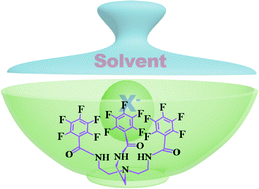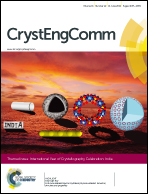Recognition of fluoride in fluorophenyl attached tripodal amide receptors: structural evidence of solvent capped encapsulation of anion in a C3v-symmetric tripodal cleft†
Abstract
A new 2,3,4,5-tetrafluorophenyl substituted tripodal amide-based receptor L1 and its pentafluorophenyl substituted analogue L2 were explored for halide binding studies in their solution and solid states. Comparative solution state binding studies of halides with L1 and L2 were carried out by 1H-NMR titration in CDCl3. Detailed solution state 1H-NMR studies show that halides bind with L1 and L2 with 1 : 1 stoichiometry in general. Binding constants of the halides with L1 and L2 were calculated by 1H-NMR titration studies where the fluoride shows selectivity over other halides and the fluoride binding constants (log K) with these two receptors were found to be 3.94 and 3.35, respectively. Single crystal X-ray structure analysis of the triamide receptors, L1 and L2, revealed two different conformations where L1 possesses a pre-organized C3v symmetric tripodal cleft, whereas in the case of L2 three arms are devoid of structural pre-organization to achieve a C3v symmetric cleft. Single crystal X-ray diffraction studies of the cases of complexes formed between L2 and fluoride/chloride, [L2(F)(CHCl3)][N(Bu)4] (1) and [L2(Cl)(CHCl3)][N(Bu)4] (2), respectively, were also carried out to elucidate the structural evidence of anion encapsulation. A detailed structural analysis of complexes 1 and 2 shows that the fluoride and chloride are engulfed in the C3v symmetric cavity of L2 with three strong N–H⋯anion interactions where a CHCl3 molecule acts as a cap that closes the open end of the C3v symmetric cleft via C–H⋯anion and CHCl3⋯C6F5 interactions.

- This article is part of the themed collection: International Year of Crystallography Celebration: India

 Please wait while we load your content...
Please wait while we load your content...